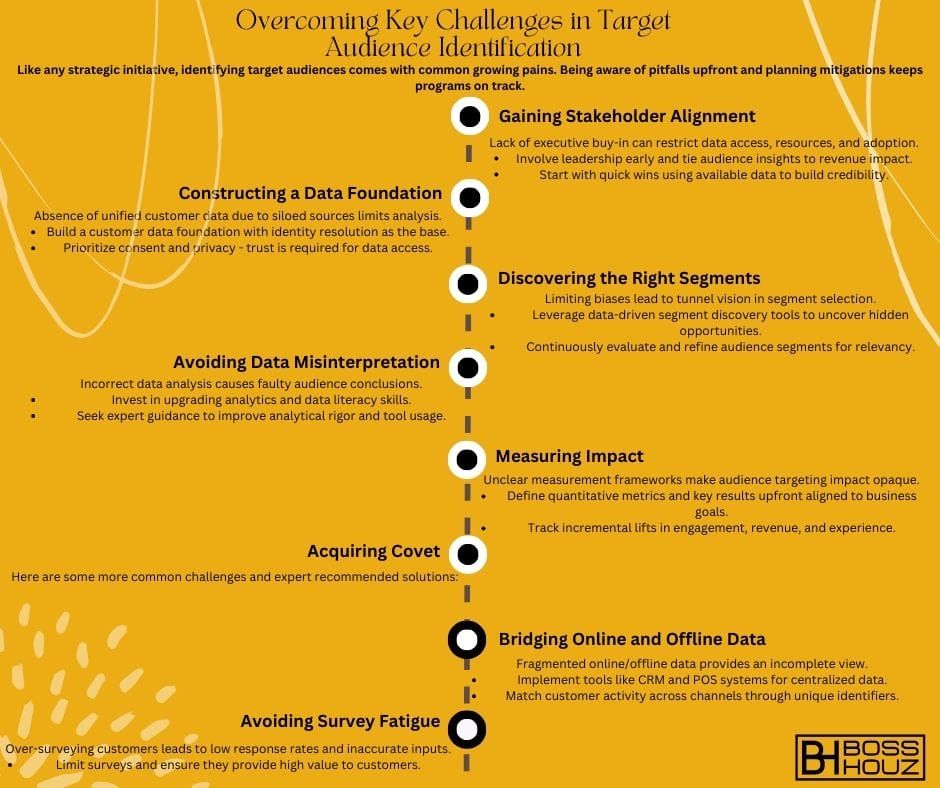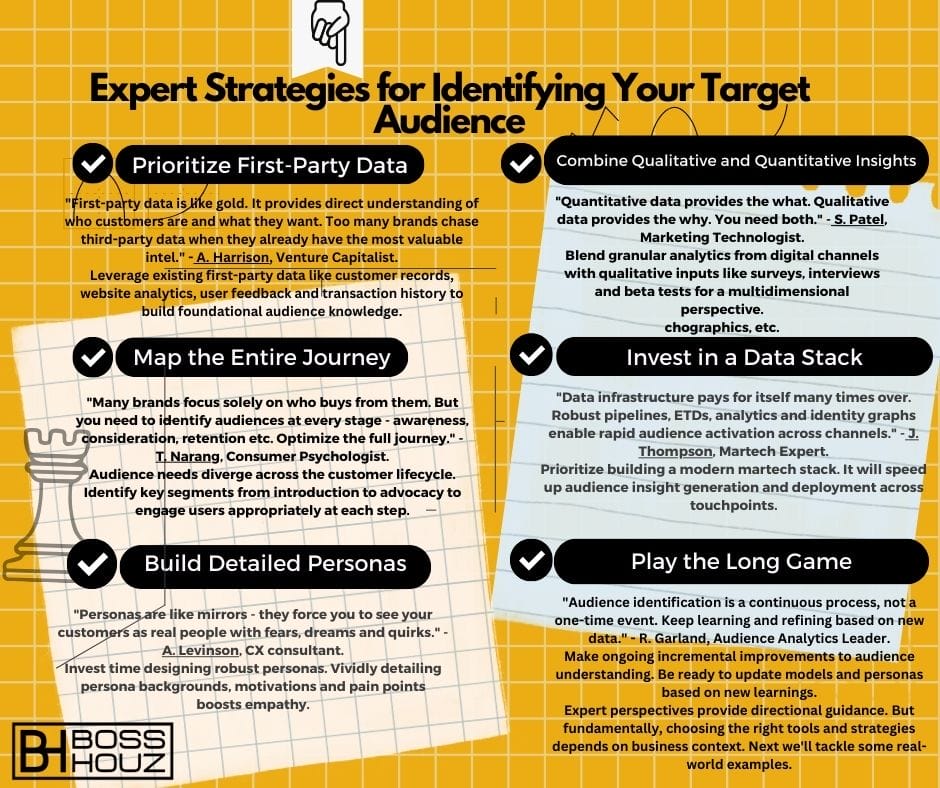Understanding who your target audience is can make or break your business. With people bombarded by a dizzying amount of choices and information every day, ensuring your messaging resonates with the right people at the right time is pivotal.
In this guide, I will provide an in-depth look at target audience identification, from examining its importance to utilizing the latest tools and technologies. Read on to unlock exclusive insights from industry experts that can rapidly enhance your marketing and growth potential.
Table of Contents
The Growing Significance of Target Audience Identification
In today’s oversaturated media landscape, precisely identifying your target audience is no longer optional – it’s an absolute must.
With endless consumer choices, a fragmented media environment, and decreasing attention spans, your success hinges on connecting with the right people at the right scale.
Let’s examine some compelling statistics that highlight why target audience identification needs to be priority number one:
- 83% of businesses say clearly identifying their target audience is critical for success (HubSpot).
- Targeted messages can result in 760% higher conversion rates compared to generic content (Smart Insights).
- Emails targeted using market and customer segmentation data achieve transaction rates 6 times higher than normal campaigns (Investis Digital).
It’s clear that understanding your audience at a granular level directly translates into higher engagement, conversions, and revenue.
In addition to boosting measurable metrics, identified target audiences also enable businesses to:
- Create tailored and relevant content that resonates.
- Make informed decisions on marketing channels and platforms.
- Develop products and services that perfectly meet customer needs.
- Build committed communities and brand advocates.
Simply put, if you know exactly who you’re talking to, your probability of success skyrockets. Let’s look at some of the latest trends when it comes to identifying target audiences in the current landscape.


Current Trends in Target Audience Identification
How businesses identify their target audiences has evolved rapidly in line with shifts in technology, media, and consumer behavior. Some prevailing trends include:
The Rise of AI and Machine Learning
Sophisticated artificial intelligence and machine learning algorithms can now quickly analyze huge volumes of data to unearth valuable customer insights.
Whether it’s purchasing habits, demographics, online browsing patterns, or survey data – AI tools can rapidly mine information to identify high-value segments.
Brands like Levi’s and Starbucks use AI-powered solutions to engage customers through hyper-personalized mobile messaging and app experiences.
Goodbye Demographics, Hello Psychographics
While demographics like age, gender, and geography are easy to measure, they provide limited value. Psychographics around personality, values, interests, and habits are far more insightful for segmentation.
For instance, two 30-year old males in New York can have completely different worldviews, motivations, and behaviors.
Understanding the “why” behind purchase decisions through psychographics allows for next-level personalization.
Omnichannel Data Utilization
Customers engage with businesses across many touchpoints – website, mobile apps, online ads, email, social media, offline stores, and more.
Omnichannel data integration allows for a 360-degree view of customers by aggregating insights across all channels into a single source of truth.
This comprehensive perspective enables refined audience identification not possible using data from individual channels.
From One-Size-Fits-All to Tightly-Defined Niches
Casting a wide net to capture as large an audience as possible is no longer effective. Microtargeting super-specific niches aligned with product-market fit is far more lucrative.
Companies like Squarespace enable users to create niche websites targeted at highly specific interests like golfing, knitting, or modelling.
The dynamics are simple – ultra-focused targeting increases relevance and conversion potential.
Why Target Audience Identification is Fundamental
Now that we’ve covered the significance of target audience identification and latest trends, let’s examine the core reasons why it’s so indispensable for business growth.
Boost Marketing ROI
Shotgun marketing efforts without audience targeting lead to wasted budgets and poor conversions.
Identifying and segmenting high-value target audiences allows for optimized allocation of marketing resources.
Allocating marketing dollars where they will have maximum impact leads to exponentially higher ROI.
Create Relevant Messaging
Generic, one-size-fits-all messaging often misses the mark.
When you intimately understand your target audience – their needs, pain points, motivations – you can craft truly tailored and resonant messaging.
Relevance is key to engagement. Aligning messaging with audience wants leads to higher involvement and response.
Drive Product Success
Understanding exactly who will use your product or service allows for designing an offering perfectly suited for their needs.
Without audience insights, you risk developing features and capabilities that users neither want nor need.
Products aligned with audience needs delight users and are set up for success from the start.
Engage Informed Decisions
Data-driven decisions require deep audience understanding.
Target audience identification enables informed calls on marketing mix, channels, positioning, pricing, competitive differentiation and more.
Blind guesses no longer cut it in today’s competitive environment. Audience data leads to smart strategy.
Gain Actionable Insights
Audience identification provides specific, nuanced and actionable insights vs generic data.
Knowing 67% of users struggle with onboarding is useless. Knowing users find step 4 of the onboarding confusing is gold.
Granular audience understanding unlocks precise opportunities for optimization.
Build Loyal Communities
Targeted outreach creates feelings of understanding, resonance and belonging.
This fosters passionate brand advocates who become powerful influencers within their peer groups.
Audience insights are key to cultivating loyal brand communities and evangelist customers.
In summary, precisely understanding target audiences is the fuel that propels all marketing, product, and business decisions. It’s a fundamental prerequisite to success.
With the “why” covered, let’s explore the practical tools and techniques for identifying target audiences accurately.
The Mechanism of Target Audience Identification
Target audience identification relies on utilizing the right frameworks, models, tools and data to uncover actionable user insights. Core elements include:
Develop Target Audience Personas
Personas are detailed fictional representations of ideal target users. They provide crucial context on user demographics, behaviors, motivations, goals and pain points.
Robust personas enable easy understanding of target users as actual people. They fuel empathetic and tailored brand messaging.
Utilize Market Segmentation Models
Market segmentation divides heterogeneous markets into homogenous groups for optimized engagement.
Popular models include demographic, geographic, psychographic, and behavioral segmentation. Combining approaches provides a multidimensional view.
Segmentation streamlines audience prioritization and drives personalized product development.
Leverage Data Collection Platforms
Data analytics tools like Google Analytics and Adobe Analytics collect user data across digital channels to enable analysis.
They provide insights on website visitors like acquisition source, on-page behavior, funnels and conversions.
Integrating analytics data is vital for audience identification and campaign optimization.
Track Offline Interactions
Offline touchpoints like retail stores and call centers contain untapped data on target audiences.
Linking online and offline data provides a 360-degree customer intelligence view.
Brands use technologies like geofencing and NFC to bridge the offline data gap and refine audience understanding.
Conduct Primary Market Research
While data analytics provides the quantitative view, qualitative consumer research offers context.
Surveys, interviews, focus groups and beta testing provide direct audience feedback.
Primary research fills critical knowledge gaps and enhances persona development.
Map the Entire Journey
The customer journey often spans many touchpoints – awareness, consideration, purchase, onboarding, retention, advocacy.
Journey mapping illuminates high-value moments and channels for engagement.
Optimizing the end-to-end experience requires identifying key audiences at each journey stage.
With robust frameworks, models and tools, uncovering granular insights on target audiences becomes systematic. But the most vital ingredient is high-quality first-party data.
The Central Role of Data in Target Audience Identification
The lifeblood of accurate target audience identification is data – specifically first-party, permission-based data.
Elemental questions like “Who are our customers?”, “What are their needs?” and “How do they engage?” can only be answered through data.
Let’s examine five essential data types that enable precise audience understanding:
Demographic Data
Age, gender, location, education, income bracket, marital status – basic demographic attributes provide orientation.
While not sufficient in isolation, demographics offer a foundation for further segmentation when combined with other datasets.
Behavioral Data
User actions like site visits, downloads, purchases, engagement with email, ads or content indicate behavioral traits.
Behavioral data reveals user preferences and correlates with affinity. Highly actionable for targeting.
Psychographic Data
Psychographics analyze personality, values, opinions, attitudes, interests and lifestyles.
They are crucial for understanding the “why” behind user behaviors and decisions.
Psychographic data enables personalization at scale based on user mindsets.
Contextual Data
Context like time, location and device provides insights on user intent and situational needs.
It allows for adapting messaging and offers based on real-time circumstances.
Context fills critical gaps by sharing the conditions behind user actions.
Conversational Data
Direct feedback from conversations via live chat, service calls, surveys and social media provides explicit audience input.
This qualitative data delivers definitive user opinions and desires. Invaluable for persona building.
Combining behavioral, demographic, psychographic, contextual and conversational data produces comprehensive and multidimensional target audience understanding.
But data alone isn’t enough. Cutting-edge technology is required to make sense of it all.
AI and Machine Learning – The Driving Forces Behind Audience Identification
Given today’s data explosion, the crucial ingredients for extracting value are artificial intelligence and machine learning.
The capabilities of AI/ML allow brands to rapidly mine data, find correlations and derive insights for precise audience targeting. Here’s how:
Process Data at Scale
AI tools can analyze millions of data points across diverse sources in seconds, uncovering patterns human analysts would miss.
The scalability of machine intelligence enables a holistic perspective by connecting massive datasets.
Automate Experiential Learning
ML algorithms get smarter over time as they process more data, without additional programming.
Automated learning algorithms constantly refine audience models and targeting as new data is ingested.
Discover Hidden Insights
Sophisticated AI like neural networks uncover non-linear relationships and subtle patterns in data that people can’t easily detect.
Machine learning provides a distinct edge in revealing breakthrough audience and personalization opportunities.
Deliver Individualization
Granular personalization leverages AI to match users with tailored content, offers, and experiences based on their profile.
One-on-one messaging and product customization based on user wants and behaviors drives engagement.
Enable Predictive Modeling
Based on historical data, Machine Learning can forecast future trends, behaviors and outcomes.
Predictive analytics allow brands to get in front of audience needs before they arise. Proactive vs reactive.
Optimize Allocation
AI directs budget and resource allocation toward high-value tasks via programmatic optimization of business priorities and processes.
More time on strategic initiatives, less on grunt work. Audience targeting provides focus.
Together, AI and ML enable a scale of audience insight and personalization unachievable through conventional analytics and segmentation approaches.
But technology is only part of the solution. Let’s cover some proven strategies for target audience identification based on expert wisdom.
Expert Strategies for Identifying Your Target Audience


Here are some top tips from industry leaders on formulating a winning audience identification strategy:
Prioritize First-Party Data
“First-party data is like gold. It provides direct understanding of who customers are and what they want. Too many brands chase third-party data when they already have the most valuable intel.” – A. Harrison, Venture Capitalist.
Leverage existing first-party data like customer records, website analytics, user feedback and transaction history to build foundational audience knowledge.
Combine Qualitative and Quantitative Insights
“Quantitative data provides the what. Qualitative data provides the why. You need both.” – S. Patel, Marketing Technologist.
Blend granular analytics from digital channels with qualitative inputs like surveys, interviews and beta tests for a multidimensional perspective.
Map the Entire Journey
“Many brands focus solely on who buys from them. But you need to identify audiences at every stage – awareness, consideration, retention etc. Optimize the full journey.” – T. Narang, Consumer Psychologist.
Audience needs diverge across the customer lifecycle. Identify key segments from introduction to advocacy to engage users appropriately at each step.
Invest in a Data Stack
“Data infrastructure pays for itself many times over. Robust pipelines, ETDs, analytics and identity graphs enable rapid audience activation across channels.” – J. Thompson, Martech Expert.
Prioritize building a modern martech stack. It will speed up audience insight generation and deployment across touchpoints.
Build Detailed Personas
“Personas are like mirrors – they force you to see your customers as real people with fears, dreams and quirks.” – A. Levinson, CX consultant.
Invest time designing robust personas. Vividly detailing persona backgrounds, motivations and pain points boosts empathy.
Play the Long Game
“Audience identification is a continuous process, not a one-time event. Keep learning and refining based on new data.” – R. Garland, Audience Analytics Leader.
Make ongoing incremental improvements to audience understanding. Be ready to update models and personas based on new learnings.
Expert perspectives provide directional guidance. But fundamentally, choosing the right tools and strategies depends on business context. Next we’ll tackle some real-world examples.
Tailored Applications for Audience Identification
While universal best practices exist, smart audience identification strategies require customized application based on:
Business Model and Offerings
B2B SaaS tools have very different users than B2C online fashion stores. Unique business and product attributes determine relevant audience data.
A travel site would emphasize demographics, trip purpose and travel party size. A B2B tool may focus on company size, role and pain points.
Current Data Maturity
Data infrastructure evolves over time. Startups may depend more on surveys while larger enterprises leverage customer databases and analytics pipelines.
Meeting businesses where they are and creating incremental audience identification improvements is key.
Resources and Goals
Limited budgets and constrained resources necessitate tactical plans focused on the highest value activities.
Sorting goals by revenue impact and ease of implementation allows planned and phased audience targeting.
Pre Existing Knowledge
Background context affects the audience identification approach.
Businesses with long operating histories already have intuitive audience familiarity. New ventures need fundamental audience discovery.
Custom strategies aligned with business realities provide the most value. Some examples:
Example 1: Ecommerce Brand
- Focused persona development based on CRM data, web analytics, email metrics, surveys, and customer service logs.
- Keyword and competitor analysis to identify high-potential affinity targets.
- Quasi-experimental testing with controlled offer variations sent to audience segments.
- AI-based predictive modeling to forecast purchase probability across products.
Example 2: B2B Company
- In-depth win/loss analysis and buyer interviews to understand missed opportunities.
- Account profiling by industry, company size, and functional role for hyper-targeted outreach.
- Journey mapping and service blueprinting to optimize business buyer experience.
- Ideal Customer Profile (ICP) modeling with Firmographic data to qualify inbound leads.
Example 3: Nonprofit Organization
- Donor segmentation by value, frequency, and channel to prioritize stewardship.
- Lookalike modeling with third-party data to find similar donors for acquisition.
- Campaign customer matchback analytics to measure ROI across marketing channels.
- Volunteer personas based on motivations, interests, and availability to improve engagement.
The examples above demonstrate how audience identification strategies manifest differently based on context.
Businesses must shape solutions around their unique objectives, constraints, and knowledge gaps.
While the applications are wide-ranging, some challenges in implementation are near universal. Let’s tackle the most common next.
Overcoming Key Challenges in Target Audience Identification


Like any strategic initiative, identifying target audiences comes with common growing pains. Being aware of pitfalls upfront and planning mitigations keeps programs on track.
Gaining Stakeholder Alignment
Lack of executive buy-in can restrict data access, resources, and adoption.
- Involve leadership early and tie audience insights to revenue impact.
- Start with quick wins using available data to build credibility.
Constructing a Data Foundation
Absence of unified customer data due to siloed sources limits analysis.
- Build a customer data foundation with identity resolution as the base.
- Prioritize consent and privacy – trust is required for data access.
Discovering the Right Segments
Limiting biases lead to tunnel vision in segment selection.
- Leverage data-driven segment discovery tools to uncover hidden opportunities.
- Continuously evaluate and refine audience segments for relevancy.
Avoiding Data Misinterpretation
Incorrect data analysis causes faulty audience conclusions.
- Invest in upgrading analytics and data literacy skills.
- Seek expert guidance to improve analytical rigor and tool usage.
Measuring Impact
Unclear measurement frameworks make audience targeting impact opaque.
- Define quantitative metrics and key results upfront aligned to business goals.
- Track incremental lifts in engagement, revenue, and experience.
Acquiring Covet
Here are some more common challenges and expert recommended solutions:
Bridging Online and Offline Data
Fragmented online/offline data provides an incomplete view.
- Implement tools like CRM and POS systems for centralized data.
- Match customer activity across channels through unique identifiers.
Avoiding Survey Fatigue
Over-surveying customers leads to low response rates and inaccurate inputs.
- Limit surveys and ensure they provide high value to customers.
- Make survey participation easy and rewarding.
Tying Insights to Action
Audience insights that aren’t actionable don’t impact outcomes.
- Frame recommendations on audience targeting concretely with next steps.
- Ensure audience analytics connects directly to marketing and product priorities.
Managing Stakeholder Skepticism
Audience models contradicting conventional wisdom face internal resistance.
- Proactively address concerns by emphasizing methodology and data lineage.
- Highlight incremental target audience wins to build confidence over time.
Planning for Data Evolution
Insights degrade without updating as consumer behavior changes.
- Build mechanisms to continually refresh audience data from various sources.
- Expect audience targeting to be a persistent workstream rather than a one-off project.
With proactive planning, even pervasive challenges can be addressed through tailored solutions appropriate for the business context.
Audience identification is a continuous optimization process. Let’s conclude by looking at emerging trends shaping its future.
The Cutting Edge: Innovations in Audience Identification
Target audience identification leverages bleeding edge technologies to drive precision and value.
Next-Generation Psychographics
Sophisticated psychometric analysis based on neuroscience and behavioral psychology provides unparalleled understanding of customer motivations and traits.
Flexible Machine Learning
AutoML democratizes AI by enabling non-technical users to generate custom ML models for audience insights without coding.
Decentralized Identity
Self-sovereign identity puts users in charge of their data, increasing trust. Brands must request access to consumer data when needed.
Embedded Analytics
Analytics instrumentation within products captures contextual in-the-moment user data, reducing blindspots.
Synthetic Data
AI-generated synthetic datasets enlarge audience understanding by modeling fictional individuals based on data patterns.
Predictive Audiences
Lookalike modeling and propensity scoring allow brands to predict best future customers based on existing user data.
Audiences of One
Hyper-personalization with localized, real-time, and context-aware messaging enables tailoring at massive scale.
Privacy Preservation
Differential privacy, anonymization, and federated learning techniques ensure privacy-first audience data analysis.
Reality Mining
Sensors in products and environments combined with wearables permit analyzing subconscious behaviors and real-world interactions.
The possibilities to refine audience identification will only expand over time as technology progresses.
Final Thoughts on Identifying Your Target Audience
We’ve covered a lot of ground in this Blog. Here are the key takeaways on target audience identification:
- Precise audience targeting is the cornerstone of marketing and product success. It enables relevance, personalization and community building.
- Utilizing market segmentation frameworks, robust data, and psychographic personas provides a multidimensional understanding of customers.
- AI and ML technology allow rapid audience insight discovery and activation across channels and the customer journey.
- Tailored strategies based on business context and clear measurement provide focused value. Proactive planning mitigates common challenges.
- Continuous refinement of target audience knowledge based on new data and innovations sustains competitive advantage.
Audience identification creates a strategic compass for businesses in turbulent times. Follow these best practices illuminated by experts to find and engage your true north.
The time for action starts now. Begin reviewing your existing data and priming key stakeholders. With precise audience focus, prepare to hit growth goals out of the park.








